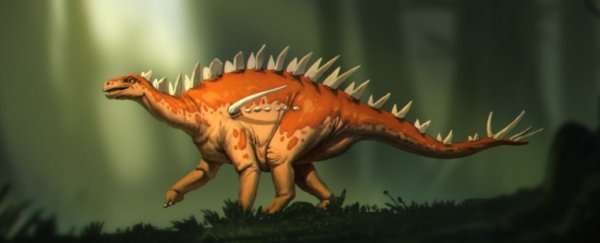A newly discovered fossilized stegosaur found in China is the most ancient ever found in Asia, and could be the oldest in the world.
Treading the Earth some 170 million years ago, during the Middle Jurassic Bajocian age, the beastie was also small for a stegosaur, measuring just 2.8 meters (just over 9 feet) from its nose to the tip of its spiny tail; larger stegos could grow up to 9 meters long.
It's unclear whether the specimen is an adult or baby, but its discovery could tell us more about how the stegosaurus genus evolved – a process about which we know woefully little.
The remains consisted of bones from the shoulder, back, thigh, feet, spine, and ribs, as well as several armor plates. These enabled a team of paleontologists led by Dai Hui from Chongqing Bureau of Geological and Mineral Resource Exploration and Development to make comparisons with other stegosaur species.
They found that, while the newly found stego, named Bashanosaurus primitivus, has features in common with other stegosaurs, some features seem to be unique. Its shoulder is smaller and less developed, its thighbone is slightly different, and its armor plates are narrower across, but thicker at the base.
Interestingly, it also has some characteristics in common with the first armored dinosaurs, which lived some 20 million years earlier. This suggests that Bashanosaurus could be a "missing link" between these older dinosaurs and the later stegosaurs.
"Bashanosaurus can be distinguished from other Middle Jurassic stegosaurs, and clearly represents a new species," Hui said.
"What's more, our analysis of the family tree indicates that it is one of the earliest-diverging stegosaurs along with the Chongqing Lizard (Chungkingosaurus) and Huayangosaurus. These were all unearthed from the Middle to Late Jurassic Shaximiao Formation in China, suggesting that stegosaurs might have originated in Asia."
Stegosaurs are among the most beloved of the Jurassic dinosaurs. The herbivorous beast was protected by plates of armor down the length of its spine and wicked spikes protruding from the end of its tail, to be wielded like a club.
Other characteristics include quadrupedal locomotion, and a tiny little head, surprisingly dainty on such a tank-like body.
These physical traits are characteristic of the genus, and Bashanosaurus appears to have had them too. But it also bears some similarities with early thyreophorans, the armored dinosaurs from which stegosaurs emerged, as well as early stegosaurs such as Gigantspinosaurus and Huayangosaurus, both also from China.
These similarities can be seen in the tail vertebrae, which are more elongated; a narrower, but flaring shoulder blade; and a lack of deep depressions in the spinal vertebrae. These similarities and differences suggest that Bashanosaurus is placed quite early on the stegosaurus family tree, which means that it represents quite an important discovery for understanding the genus.
"The discovery of this stegosaur from the Middle Jurassic of China adds to an increasing body of evidence that the group evolved in the early Middle Jurassic, or perhaps even in the Early Jurassic, and as such represent some of the earliest known bird-hipped dinosaurs," said paleontologist Susannah Maidment of the London Natural History Museum in the UK.
"China seems to have been a hotspot for stegosaur diversity, with numerous species now known from the Middle Jurassic right the way through until the end of the Early Cretaceous period."
The research has been published in the Journal of Vertebrate Paleontology.
